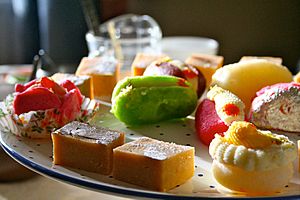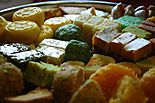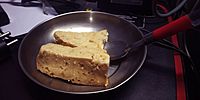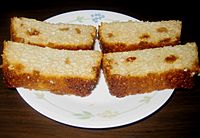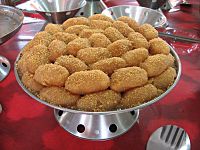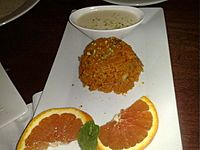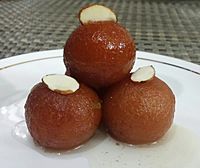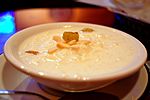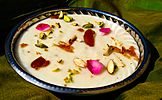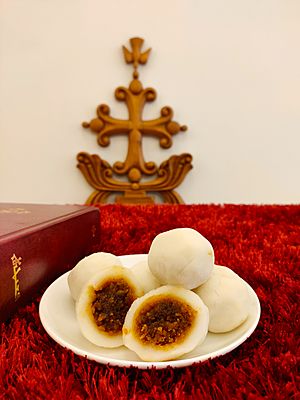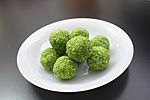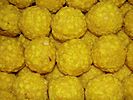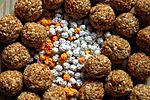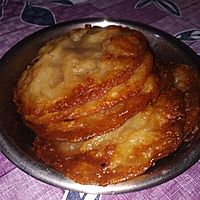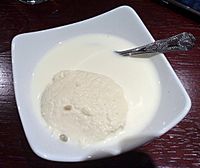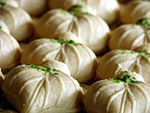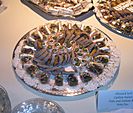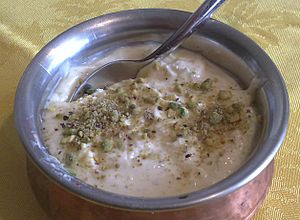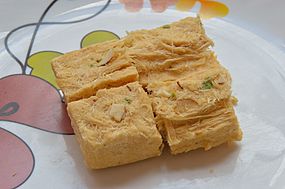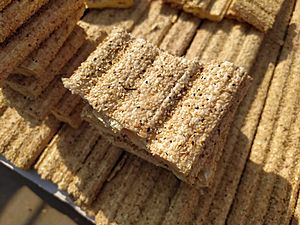Sweets from the Indian subcontinent facts for kids
A sample of sweets from the Indian subcontinent
|
||||||||||||||
Mithai are delicious sweets and desserts from the Indian subcontinent. This area includes countries like India, Bangladesh, Nepal, Pakistan, and Sri Lanka. You can find thousands of shops in these countries that sell only sweets!
People in the Indian subcontinent have been growing sugarcane for thousands of years. They even invented how to make refined sugar about 8,000 years ago. The English word "sugar" comes from the Sanskrit word sharkara. The word "candy" comes from the Sanskrit word khaanda, which means unrefined sugar.
Over a long time, the food cultures of the Indian subcontinent created many different kinds of sweets. Some people say that no other place in the world has as many varied and meaningful sweets as this region.
Sweets are called by many names in different languages across the Indian subcontinent. Mithai is one common name. These sweets are made with sugar and many other things. These include different flours, milk, milk solids, and even root vegetables. They also use seeds, fresh fruits, fruit pastes, and dry fruits.
Some sweets like kheer and barfi are cooked. Others, like Mysore pak, are roasted. Some, like jalebi, are fried. And some, like kulfi, are frozen. Many sweets use a mix of these cooking methods. The ingredients and recipes change from one region to another.
Mithai are sometimes eaten with meals. They are also a big part of greetings, celebrations, and religious offerings. People give them as gifts and serve them at parties. During South Asian festivals like Holi, Diwali, and Raksha Bandhan, families make or buy sweets to share. Sweets are a key part of many social gatherings, weddings, and religious events.
History of Sweets in the Indian Subcontinent
Ancient writings from India, called Sanskrit literature, talk about feasts and sweet offerings. The Rigveda, a very old text, mentions a sweet cake called apūpa. This cake was made from barley flour, fried in butter, or boiled in water, and then dipped in honey. A sweet called Malpua today is very similar to this ancient cake.
One of the best old texts that describes sweets is the Mānasollāsa. This ancient book is like an encyclopedia of food, music, and other Indian arts. King Somesvara III wrote it around 1130 CE. The book describes meals that include a rice pudding called payasam, which is known as kheer in other South Asian languages.
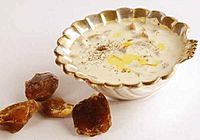
The Mānasollāsa also shares recipes for other sweets. These include golamu, a donut made from wheat flour with cardamom. It also mentions gharikas, which are fried cakes made from black gram flour and sugar syrup. Another sweet is chhana, a fresh cheese and rice flour fritter soaked in sugar syrup. The book also describes how to make milk solids and condensed milk for sweets.
Sweets in the Indian subcontinent date back to at least 500 BCE. Records show that both raw sugar (like gur or jaggery) and refined sugar were made then. By 300 BCE, government officials in India recognized five different kinds of sugar. During the Gupta dynasty (300–500 CE), sugar was made from sugarcane and other plants like palm trees.
Sugar-based foods were also used as offerings in temples for gods. After prayers, these offerings became prasād and were shared with people.
Popular Types of Mithai
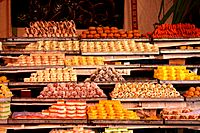
Here are some of the many delicious sweets you can find in the Indian subcontinent:
Adhirasam
Adhirasam is a sweet that looks a bit like a doughnut. It comes from Tamil cuisine. It is made from rice flour, jaggery (a type of unrefined sugar), butter, and pepper.
Bal Mithai
Bal mithai is a brown, chocolate-like fudge. It is made from roasted khoya (milk solids) and covered with small white sugar balls. This sweet is very popular in the Kumaon region. It is believed to have been created in the markets of Almora in the early 1900s.
Barfi
Barfi is a sweet made from milk solids or condensed milk. Other ingredients like ground cashews or pistachios are often added. Some barfis use different flours, such as besan (gram flour). Barfi can be flavored with fruit pastes or pieces, like mango, banana, berries, or coconut. Spices like cardamom and rose water are also used for flavor.
Chhena Murki
Chhena murki is a sweet made from an Indian type of cottage cheese, milk, and sugar. It started in Bhadrak but is now popular in Odisha and other parts of India. To make it, milk and sugar are boiled until thick. Then, cottage cheese is soaked in this mixture. People usually add flavors and spices.
Chhena Poda
Chhena poda means 'burnt cheese' in the Odia language. It is a dessert from Odisha. It is made from well-kneaded chhena, sugar, cashews, and raisins. It is baked for several hours until it turns brown.
Chikki
Chikki is a solid, crunchy sweet that is ready to eat. It is usually made by mixing dry nuts with hot jaggery syrup. The most common type is made with peanuts and jaggery. Besides almonds, cashews, walnuts, and sesame seeds, chikki can also be made from puffed rice or other grains. Chikki is often a high-protein treat.
Chomchom
Chomchom is a traditional Bengali sweet. It is made from flattened paneer (a type of cheese from curdled milk) that is sweetened in syrup.
Gajrela
Gajrela, also called Gajar halwa, is a seasonal pudding-like sweet made from carrots. It is popular in the Punjab regions of India and is now common across the Indian subcontinent. It is made by slowly cooking shredded carrots with ghee (clarified butter), concentrated milk, mawa (khoya), and sugar. It is often served with spices, almonds, cashews, or pistachios.
Gulab Jamun
Gulab jamun is a very common sweet in the Indian subcontinent. It is made from fried chenna (milk solids and cheese) balls. These balls are then soaked in a sweet syrup flavored with rose water.
Jalebi and Imarti
Jalebi and Imarti are made by deep-frying a fermented batter of wheat flour and yogurt. The batter is shaped into a circular coil. Then, it is soaked in sugar syrup. Imarti is a type of Jalebi, but it uses a different flour mix and has tighter coils. Jalebi is usually brown or yellow, while Imarti is reddish. These sweets are often enjoyed with milk, tea, yogurt, or Lassi.
Kesari Bhath
Kesari Bhath is a sweet dish made from semolina, sugar, and ghee. It is believed to have started in Kannada cuisine. It has a soft, grainy texture, similar to halwa. The semolina is roasted and boiled with a little water. Once the water is gone, sugar and ghee are added. Cardamom and cloves are often added for a nice smell.
Khaja
Khaja is a sweet from India. Its main ingredients are refined wheat flour, sugar, and oils. It is thought that Khaja was made in the southern parts of Bihar even 2000 years ago. Today, Khajas are made and sold in cities like Patna and Gaya. The Khajas from Silao and Rajgir are known for being very puffy.
Khajas have also become popular in other parts of the Indian subcontinent, like Andhra Pradesh and Odisha. The Khaja from Kakinada, a town in Andhra Pradesh, is famous in South India. This Khaja is dry on the outside and full of sugar syrup inside. The Khaja of Puri is also very well-known.
Kheer, Phirni, and Payasam
Kheer is a pudding usually made from milk, sugar, and one of these ingredients: vermicelli, rice, bulgur wheat, semolina, or tapioca. It is also known as payasam. Phirni is a popular type of kheer.
Payasam has been an important dish throughout the history of the Indian subcontinent. It is often served during ceremonies, feasts, and celebrations. In many parts of India, old traditions say that a wedding is not fully blessed if payasam is not served. Some families also serve kheer as a good luck food before someone goes on a long journey.
Kozhukatta
Kozhukatta is a traditional sweet dumpling from Kerala and Sri Lankan Catholics. It is made from thickened rice flour. The filling can be made with coconut, jaggery, or sugar. It is similar to modak and mochi.
Kulfi
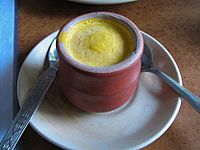
Kulfi is a traditional South Asian ice cream. It is made by slowly cooking flavored milk until it becomes thick and caramelized. A small amount of rice or grain flour is added. Once it is thick, dry nut pastes and spices are mixed in. Then, the mixture is frozen in small clay or metal pots. This makes a very dense frozen dessert. Kulfi is usually served very cold.
Kulfi comes in many flavors like mango, saffron, pistachios, almond (badam), coconut, and plain. It is also a popular street snack in summer and during festivals. Food sellers called kulfiwalla carry it in large clay pots and play a special horn to attract customers.
Laddu
Laddu (also spelled laddoo) are round sweets made from different flours, grains, pulses, or semolina. They can also include fruits, dry fruits, and other ingredients cooked with sugar. These are then shaped into small or large balls. Laddu are mentioned in ancient Sanskrit texts as temple offerings. They are popular all over India and come in many varieties. Laddu are often served during festivals, religious events, or family celebrations like weddings.
One example is Motichoor ka Ladoo. This sweet is popular in states like Bihar. It is made from roasted gram flour flakes that are sweetened, mixed with almonds, and then fried in ghee. Each tiny ball, called a boondi, melts in your mouth. These mini balls are combined with spices and then formed into bite-sized spheres called motichoor ka ladoo.
Malpua
Malpua is a deep-fried pancake made from wheat or rice flour. It is then soaked in sugar syrup. It is popular in Bangladesh, East India, and Nepal.
Pathishapta
Pathishapta is a Bengali dessert. It is a rolled pancake filled with a mixture of coconut, milk, cream, and jaggery from date palm. These desserts are also eaten in Thailand.
Pongal
Pongal is a sweet dish traditionally made during Pongal, the Tamil harvest festival.
Rasgulla
Rasgulla is a very popular sweet in the Indian subcontinent. It comes in many forms, like Kamalabhog (orange rasgulla) and Rajbhog (filled with dry fruits and khoya). Some are white, while others are cream, brown, gold, or orange. In Nepal, they are called Rasbari.
This sweet is made by boiling small dumplings of chhenna (cheese curds) and semolina in sugar syrup. After cooking, they are kept in the syrup, which makes them spongy. Some Rasgulla are filled with treats like dry fruits or raisins. Some types, called danedhar, are taken out of the syrup and coated with sugar. These are festive foods found all year in many parts of India.
Ras Malai
Ras malai is made of flattened balls of chhena (cheese curds). These are soaked in malai (clotted cream) that is flavored with cardamom. Its name comes from the words ras (juice) and malai (cream).
Sandesh
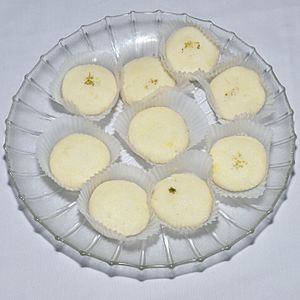
Sandesh is a Bengali sweet. It is made from chhena (cheese curds) mixed with sugar. A type called nolen gurher sandesh uses date molasses instead of sugar.
Sel Roti
Sel roti is a homemade circular bread or rice donut from Nepal. It is prepared during Tihar, a big Hindu festival in Nepal and parts of India. It is made from rice flour and can have different flavors. A semi-liquid dough is made by adding milk, water, sugar, butter, cardamom, and cloves.
Shrikhand
Shrikhand is a traditional dessert from Gujarat and Maharashtra. It is made from strained yogurt, sugar, saffron, and cardamom. It has a smooth, creamy texture and is served chilled.
Soan Papdi
Soan papdi is a sweet mostly made of sugar. It is pulled to create thin strands that look like cotton candy. It is flaky and crunchy and melts in your mouth. It is usually packaged in cubes and topped with chopped pistachio nuts. It can also be served in a rolled paper cone. Many flavors can be added, such as mango, strawberry, pineapple, and chocolate.
Tiler Khaja
Other Delicious Sweets
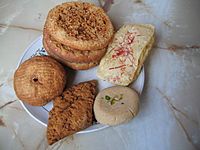
Here are some other traditional Indian sweets and desserts:
- Mysore pak (a dessert made from ghee, sugar, and chickpea flour)
- Halwa (made from flour, butter, and sugar)
- Jangiri
- Jhajariya
- Dharwad pedha
- Karadantu
See also
 In Spanish: Dulces de la India para niños
In Spanish: Dulces de la India para niños














